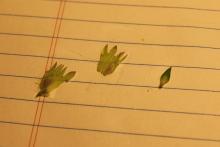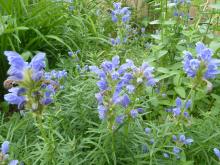Over the years I've grown quite a few Dracocephalum species, including D. argunense. I've also grown an extremely similar plant, which originally came to me as D. ruyschiana. I've compared the two dozens of times, and I've never been able to really distinguish between them. I've consulted with some of my BNARGS Chapter members, including Lori Chips and Anne Spiegel, and in general everyone seems to agree that what I've got, and what everyone else in the Northeast has got, is D. argunense. I've not been able to find anyone who actually is growing D. ruyschiana, and I'd like to get either reliable seed or a plant or two so I can grow them and see the differences in real life. Any suggestions? Any experience with D. ruyschiana?
Comments
Re: Dracocephalum
It's a fine looking plant, useful for the late bloom period; I used to grow a number of Dracocephalum species. Comparing D. argunense and D. ruyschiana in the Flora of China keys, the two species are very closely related and come down to a "couplet" in the key, where the two species are narrowly separated. Both have lanceolate needle-like leaves, of about the same range in size. Notice that one of the synonyms of D. argunense is D. ruyschiana var. argunense.
The main difference separating the two species is the larger flower size of D. argunense, and very subtle difference in hairiness of stems and calyxes.
[attachimage=1]
Re: Dracocephalum
Thanks to both of you for your responses. Mark's comments certainly make it at least appear that distinguishing between them might be 'splitting hairs,' but if I do get some seed from Lori, I'll make sure to plant it right next to one of the D. argunense so comparison will be easy.
Re: Dracocephalum
Dang, here I thought I had it cold! I'll have to go out and look really closely. Thanks for the info, Mark!
Re: Dracocephalum
So, the flowers on my plants have corolla lengths (excluding the calyx, when the flower tube is intact within the calyx) of 1.5 to 1.7 cm, definitely smaller than those of D. argunense, according to eFlora of China (and smaller than the so-labelled D. argunense I've grown).
With a 10x hand lens, the calyces appear to be "minutely" hairy, at least at the tips (not so sure about the base); the stems are hairless in the upper parts, but again, "minutely" hairy toward the base (very subtle!)
The leaves are up to 4cm long (basal are longest) and up to 4mm wide.
I have slit open a couple of calyxes - they look rather more like D. argunense in the eFlora of China illustration, as does the comparative size/shape of the bract:
So...
Well, in flower size, at any rate, it appears closer to D. ruyschiana! ???
Re: Dracocephalum
Peter, I am wondering what your "people" use to distinguish the two. My ryuschiana is only first time blooming this year from NARGS seed. Over with now, but one can make out something ??? on the calyx from pics I took then. I don't know if they would be called hairs. Flowers are certainly not even near the size the FoC claims for argunense.
Well I guess these pics aren't really helping any after all...
Re: Dracocephalum
Finally returning to this thread....
Well, I'm not sure if what I've grown as Dracocephalum ruyschiana is it or whether it is really D. argunense... or if the two species are just endpoints within a spectrum of variability, where it falls in the spectrum!
On the basis of the following, though, I think it's more aligned to D. ruyschiana, as the leaves on the lower stem as well as on the upper stems appear to be sessile (without petioles, stalkless).
The eFlora of China site describes D. ruyschiana as having leaves that are sessile or subsessile:
http://www.efloras.org/florataxon.aspx?flora_id=2&taxon_id=200019594
The lower parts of D. argunense are described as having leaves with petioles:
http://www.efloras.org/florataxon.aspx?flora_id=2&taxon_id=200019566
Whatever it is, I did save seeds so if you are still interested, Peter, please let me know and send your address. :)
Re: Dracocephalum
Dracocephalum ruyschiana (= dragehode) is a Norwegian native (it is very rare in Europe and red-listed though). However I have never (at least not since childhood) seen plants in the wild but it is not uncommon around Oslo where I grew up.
Here are pictures of the real species: http://www.kristvi.net/flora/D/dragehode.htm






Hi, Peter!
I've grown D. ruyschiana for over a decade here, originally from seed. I believe that it's quite readily distinguished from D. argunense by it's narrow foliage, which matches the eFlora of China description (below). I can certainly send you seed later on. (It's only fairly recently started to bloom here.)
Here's a photo from last year that shows the foliage well - unfortunately the camera did not capture the blue of the flowers well (it is more intense than shown). These plants have become slightly shaded by an Amur cherry; it would likely be more compact and is more floriferous in full sun:

http://www.efloras.org/florataxon.aspx?flora_id=2&taxon_id=200019594